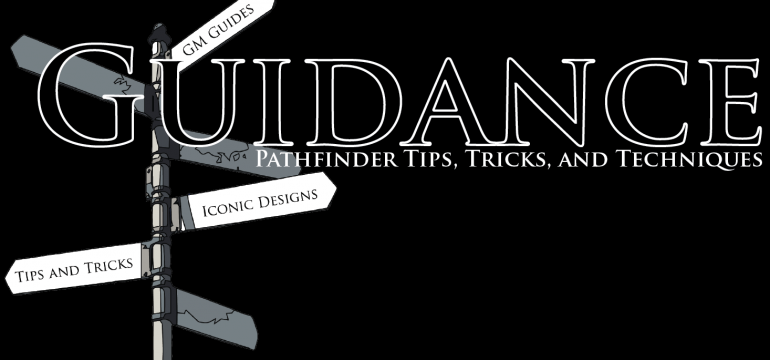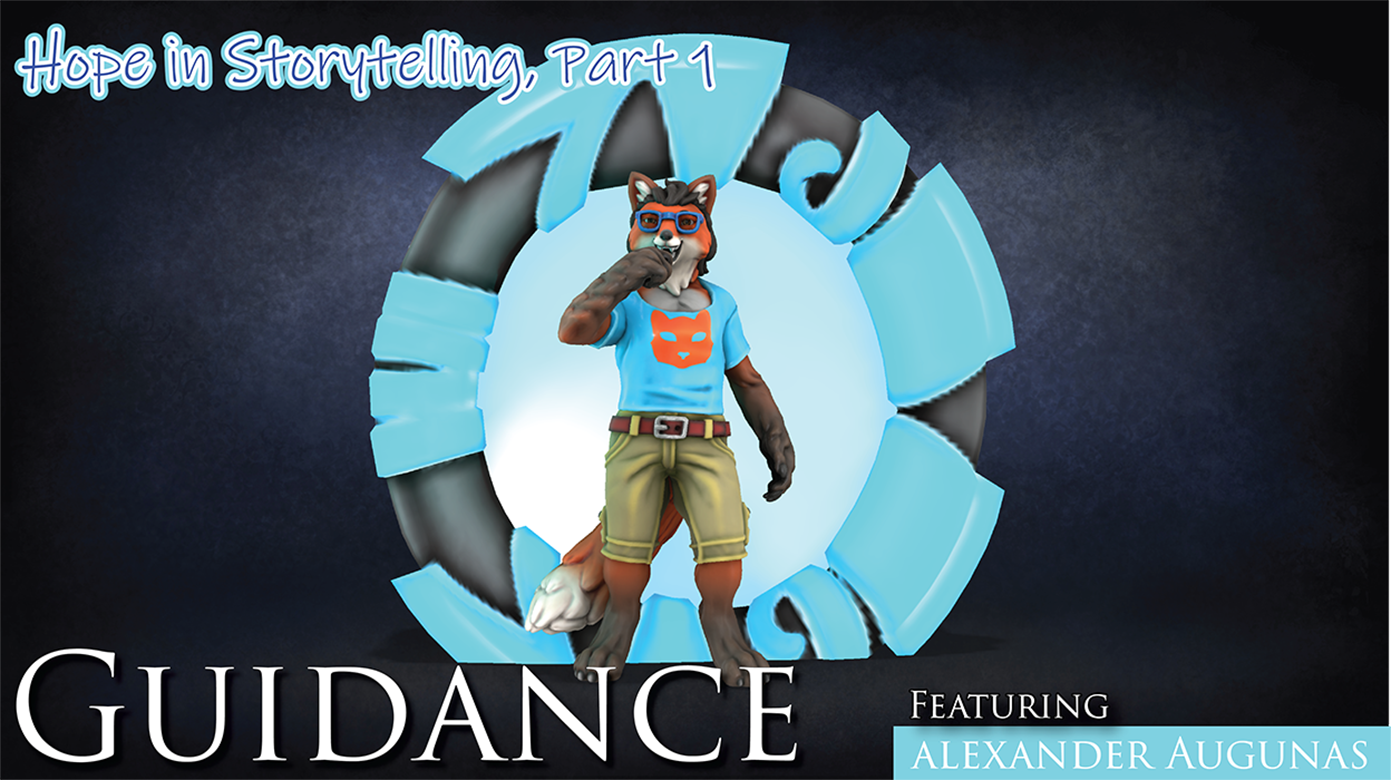Welcome to Guidance, Private Sanctuary’s source for tips and techniques for the Pathfinder Roleplaying Game, written by Everyman Gamer Alexander Augunas. Today, we’re going to be talking about the sneak attack class feature.
Sneak attack is arguably one of the most iconic class features in the Pathfinder Roleplaying Game, but many new players don’t understand how it works and why. In today’s article, we’re going to be dissecting the sneak attack rules and talking about some options that make it work for new and veteran players alike.
What is “Sneak Attack?”
Sneak attack is a class feature that is most commonly associated with the rogue, although several classes have a similar (often identical) class feature as well. The standard sneak attack text, as immortalized by the rogue class, has been reproduced below for convenience.
If a rogue can catch an opponent when he is unable to defend himself effectively from her attack, she can strike a vital spot for extra damage.
The rogue’s attack deals extra damage anytime her target would be denied a Dexterity bonus to AC (whether the target actually has a Dexterity bonus or not), or when the rogue flanks her target. This extra damage is 1d6 at 1st level, and increases by 1d6 every two rogue levels thereafter. Should the rogue score a critical hit with a sneak attack, this extra damage is not multiplied. Ranged attacks can count as sneak attacks only if the target is within 30 feet.
With a weapon that deals nonlethal damage (like a sap, whip, or an unarmed strike), a rogue can make a sneak attack that deals nonlethal damage instead of lethal damage. She cannot use a weapon that deals lethal damage to deal nonlethal damage in a sneak attack, not even with the usual –4 penalty.
The rogue must be able to see the target well enough to pick out a vital spot and must be able to reach such a spot. A rogue cannot sneak attack while striking a creature with concealment.
When Can I Sneak Attack?
There are three basic ways to allow your attacks to sneak attack, as outlined by the rogue class. They are: 1) attacking an opponent that you are currently flanking, 2) attacking an opponent that is flat-footed, 3) attacking an opponent that is denied its Dexterity bonus against your attack. Let’s look at all three conditions briefly.
When I am Flanking: You’re considered to be flanking an opponent when you can draw a line from your square into an opponent’s square and that line directly passes through opposite sides of that creature’s square. For instance, if you’re standing to a creature’s East side, the line needs to pass through that creature’s West side; passing from East to North or West to South isn’t flanking. In layman’s terms, this means that you and your opponent need to be directly across from one another.
As a standard rule, it isn’t enough for your target to be flanked; you need to be actively flanking that target.
When my Opponent is Flat-Footed or Denied its Dex Bonus to AC: These two conditions are similar, so I’m going to cover them simultaneously. When you’re flat-footed, you lose your Dexterity bonus to AC. When you’re denied your Dexterity bonus to AC, you … well, you get the picture. The difference between these two states is to whom the lack of Dexterity benefits. When you’re flat-footed, you lose your Dexterity bonus to AC for EVERYTHING. All attacks made against you. It also comes with some other nasty penalties, namely you can’t make attacks of opportunity. As a result, being flat-footed is a general state of unpreparedness. Being denied your Dexterity bonus to AC, however, is less penalizing. You’re able to make attacks of opportunity just fine when you’re denied your Dexterity bonus to AC, and typically you’re only denied your Dexterity bonus to AC from one, specific source. For instance, when a creature feints you, you are only denied your Dexterity bonus to AC against attacks made by that one creature unless it has a feat or special ability that modifies the feint action.
Can I Sneak Attack Multiple Times in a Round?
Yes; every attack that meets sneak attack’s requirements counts as a sneak attack, and therefore deals sneak attack damage. This means that characters with sneak attack have the potential to deal massive amounts of damage if their attacks land successfully.
When Can’t I Sneak Attack?
The only real time that you can’t sneak attack someone is when they have concealment; simply having a miss chance isn’t good enough. This means that attacking someone shrouded in darkness, hiding in a bank of fog, or benefiting from the blur spell all can’t be sneak attacked. Additionally, sneak attack notes that you can’t sneak attack a creature if you’re unable to reach its vital organs. This is somewhat vague and is more an open invitation for GMs to fiat that the rogue’s combat effectiveness will be diminished for the encounter. Because rogues are already a dying breed, I’ve never seen a GM enforce this rule personally, but it exists. The best example would be when a creature is simply too massive to sneak attack properly. You also can’t sneak attack with a ranged weapon if you’re more than 30 feet from your target.
What Protects Against Sneak Attack?
There are plenty of ways to defend yourself from being sneak attacked. As a general rule, effects that protect against critical hits also protect against sneak attacks, but those abilities typically need to note that they do so. A good example are the Neutral aeons; these outsiders are immune to critical hits, but not to sneak attacks.
For most creatures, the fortification armor ability is the best option, as it gives you a percentile chance to flat-out nullify any sneak attack that that would harm you. This chance typically comes in the form of 25% (lesser), 50% (normal), and 75% (greater). These enchantments can be pricey at times, but luckily some spells exist that grant low-level characters similar protection.
A handful of creatures are immune to specific conditions that cause sneak attack to occur. For example, creatures outright immune to flanking can’t be dealt sneak attack damage from flanking. Also, the following types of creatures are flat-out immune to precision damage, which includes sneak attacks: creatures with the elemental, incorporeal, or swarm subtypes and oozes. Additionally, creatures with the protean subtype have a constant 50% chance to ignore all sneak attack damage as well. You’ll note that I didn’t list constructs and undead in that list, and that’s because in Pathfinder, constructs and undead don’t possess blanket immunity to sneak attacks. Most constructs and undead have vulnerable points for sneak attackers to strike, such as a rogue aiming for a zombie’s head. Looking over the creatures that I mentioned were immune to sneak attacks, only creatures without discernible, physical places to strike at are immune to sneak attacks.
Perhaps the most important defense to talk about in regards to sneak attack is uncanny dodge and improved uncanny dodge. Uncanny dodge makes a character flat-out immune to become flat-footed and invisible attackers don’t deny the character her Dexterity bonus to AC. This cuts out a rather large portion of the ways that a rogue can deal sneak attack damage. Improved uncanny dodge flat-fout makes the character immune to sneak attack damage unless confronted by a character with four or more levels of rogue than the character with improved uncanny dodge. In that regard, one might say that it takes a rogue (or a barbarian) to beat a rogue.
What are Some Strategies for Sneak Attackers?
Here are some basic tips for being an effective sneak attacker.
- Find a way to set up your sneak attack as fast as possible. This typically means having one or more way to satisfy one of those three “sneak attack on” conditions. The best ones for each condition are (in my opinion): Gang Up, Improved Two-Weapon Feint, and Shatter Defenses.
- Gang Up makes it easier to flank by allowing you to consider yourself flanking an opponent as long as two or more of your allies are also adjacent to your target. This tactic requires a lot of coordination on your (and your team’s) part. As a result, I don’t recommend it because it is difficult to corral a party to make yourself more optimal. Gang Up also has the advantage of being the only one of these three feats that is an “early level” feat; all of the others are mid game feats.
- Improved Two-Weapon Feint allows you to give up one of your highest attack bonus attacks when you make a full attack action to try and feint your target. If you succeed, your target is denied its Dexterity bonus to AC against all of your attacks. Although extremely feat intensive, this is probably the best feat of my three for getting off a bunch of sneak attacks. Unlike Gang Up, this one is self-sufficient and unlike Shatter Defenses, it is rare to find a creature that is immune to being feinted (creatures with Int 1 or 2 get a bonus against you while mindless creatures are immune).
- Shatter Defenses is the only one of the bunch that places the flat-footed condition on your target, which is important for feats like Sap Master, which only function against flat-footed targets. That said, unlike the typical flat-footed condition Shatter Defenses only renders a target flat-footed against your attacks. Shatter Defenses requires some set-up to use, typically in the form of a demoralize attempt, but once you’ve gotten a foe shaken it is by far the easiest of the three to “roll,” or keep the debuff going. You don’t really need to do anything special other than attack and you don’t take any penalties for using Shatter Defenses.
- Get a high initiative, and then delay, delay, delay! This one sounds weird, but basically you want to be able to act as soon as the conditions are right for your strategy. The best way to do this is to get your initiative up high, high enough that you act before everyone else, and then simply delay round after round while you watch the battlefield go on around you. With the exception of the slayer class, most sneak attackers aren’t built to be front-line characters, so you don’t want to charge in brazenly before you can get your combo off. Nothing is more frustrating then running into combat, setting yourself up, and watching your allies go off in every which way. Remember, YOU’RE the one who needs THEM for flanking (or to use as a meat shield), so follow THEM around.
- Pump your Attack Bonus. You’re not going to sneak attack if you can’t hit, so make sure that you can hit with whatever weapon you’re wielding. An attack that misses is worth no damage.
- Reach Weapons are Nice, especially with Gang Up. Having an extended reach can allow you to sneak attack without putting yourself in harm’s way.
- Don’t Bother with Ranged Weapons. As I mention and demonstrate in my Haley Starshine article, it is CRAZY-hard to sneak attack with ranged weapons. Its basically impossible without the Dazzling Display feat.
- Powerful Sneak isn’t worth your time. This rogue talent (and subsequent advanced talent) allow you to treat low numbers as higher ones on sneak attack dice. For the record, the average damage on a d6 is 3.5; that is, if you add all possible results together (1 + 2 + 3 + 4 + 5 + 6) and divide by the number of possible results (6), the result is 3.5. Now, if you take powerful sneak, your average looks like this; (2 + 2 + 3 + 4 + 5 + 6)/6 = 3.6. Oh goodie, .1 extra damage per sneak attack die on average! If you take the next talent in the chain and replace 1 and 2s with 3s, you get this: (3 + 3 + 3 + 4 + 5 +6) = 21/6 = 4. So taking both talents is, on average, worth half a point of damage per die. Since one feat is roughly worth 2 points of damage (source: Weapon Specialization), these talents are only worth it statistically if you’re rolling 8 or more sneak attack dice.
- Don’t be afraid to be opportunistic. Many characters with sneak attack have this mindset that they have to start attacking now, Now, NOW when everyone else attacks. You don’t. Some of the most effective rogues that I have ever seen have hung in the shadows for a round, sometimes tow, and waited for a time when they could effectively pop out of hiding and quickly sneak attack an opponent who was unaware of them. This is actually exactly what one of my best rogue players EVER, Julia, would do instinctively just from being in character at the table. And it was magnificent. She wasn’t ever the most high-damaging player, but when she popped out from hiding to make her attacks, she was typically the last thing that the enemy saw. She would also constantly remind the other players that if they wanted her to “carry her weight,” they had to help her get into a position to do so. Because ….
- Sneak Attack is all about teamwork. Even though it is associated with many “lone wolf” classes, sneak attack is better classified as a “pact wolf” ability. EVERYONE at the table needs to work together to make sneak attack an effective, powerful option. It shouldn’t fall solely to the character with sneak attack to get into a position to sneak attack, just like you wouldn’t berate the wizard or cleric from neglecting to buff you or heal you when you moved out of range. Don’t berate the rogue for being unable to sneak attack if you’re not trying to give her an opportunity to do so.
Other Tricks
Here’s a few other helpful ways to make sneak attack work a little bit better for you.
- Hunter’s Surprise (advanced talent, rogue) is a neat 1/day ability that allows every attack that you make against one target to be a sneak attack, even if you don’t meet any of the conditions. This can be helpful for niche encounters, although it isn’t reliable.
- Improved Feint / Greater Feint lets you feint faster. Its not a bad tactic, but Improved Feint isn’t as strong as Two-Weapon Feint. Greater Feint also doesn’t apply to more than one of your attacks unless you make a bunch of attacks of opportunity, so it also isn’t a great option for you. Greater Feint is better for the party fighter who wants to be nice and make it easier for YOU to sneak attack. It isn’t a strategy for you to rely on using yourself.
- Invisibility is probably the most effective way to sneak attack, but with the exception of the ninja no sneak attacker gets a good, easy way to use this tactic, so I don’t mention it. Basically, unless your foes have uncanny dodge, all of your attacks deny your opponent their Dexterity modifier to AC while you’re invisible, so it’s an easy way to satisfy sneak attack’s conditions. That said, creatures exist that can see through invisibility (like any creature with the see invisibility spell), so it isn’t a good tactic to rely on solely.
- Blinding your target is another excellent way to sneak attack. Unless they have Blind-Fight or an ability that allows them to see without eyes (like the aptly named blindsense), a blinded opponent is denied its Dexterity bonus to AC against all attacks made against it. There are a few ways to manage this (the blindness spell and Blinding Critical come to mind), but by far the most reliable is with the dirty trick combat maneuver. One good check and BOOM, your enemy can’t see anything except all those d6s you’ll be rolling.
- A relatively easy way to get a stream of sneak attacks is with the Scout archetype for rogues. At 4th level, any time you charge your attacks on the charge get to be sneak attacks. At 8th level, any time you move 10 or more feat your attacks get to be sneak attacks. If you can find a way to make all of your attacks on the charge (such as with the greater beast totem rage power), then scout’s charge becomes an incredibly potent ability, as not only do you get to make all of your sneak attacks AND move up to double your speed, but you also get the +2 bonus on attack rolls for charging. By far, this is one of the best rogue archetypes in the game if you can find a way to make this build work.
Where Can I Get Sneak Attack?
As mentioned, the rogue class is the most commonly-associated class with the sneak attack class feature, but after the printing of the Advanced Class Guide, there are other places that you can get this ability too, such as the following:
- Sandman (Bard; Advanced Player’s Guide): This archetype has a very slow sneak attack progression, but it comes with all of the goodness associated with being a bard, such as bardic spells, skill specializion, and bardic performances. You don’t get inspire courage, but you do get the ability to single people to sleep. So you can murder them harder while they’re sleeping.
- Vivisectionist (Alchemist; Ultimate Magic): Commonly cited as “the archetype that first truly replaced the rogue,” this class trades bombs for a sneak attack progression. Yup. You’re an alchemist, but you sneak attack like a rogue. Plus you can take some of the best offensive rogue talents instead of discoveries if you want too. This is a very powerful archetype that’s been banned from PFS for obvious reasons.
- Bushwacker (Kobold Gunslinger; Advanced Race Guide): Yup, now you too can play the gunslinger who can sneak attack people. That is, if you don’t mind being forced to play a kobold, although I suppose humans can opt into it with a feat. Although that’d be a REALLY weird character.
- Slayer (Base Class, Advanced Class Guide): This base class gains sneak attack at 3rd level, plus every 3 levels thereafter for a total of +6d6 damage. Not as good as the rogue, but close and has a better attack bonus to make those sneak attacks more likely to land.
- Crocodile Domain (Druid Domain, Faiths and Philosophies): At 6th level and every six levels thereafter, a druid with this domain gets +1d6 points of sneak attack damage. Not great, but not bad considering that you give up NOTHING to take this domain.
- Snakebite Striker (Brawler, Advanced Class Guide): Although it doesn’t get as many sneak attack dice as the slayer, the snakebite striker only really gives up martial flexibility (a great class feature) for those d6s of damage.
- Strangler (Brawler, Advanced Class Guide): You get more sneak attack damage dice than the snakebite striker, but they only apply while you’re grappling someone. This comes at the cost of your unarmed strike damage ogression, so you really need to stop and consider if this archetype (and its grapple-based tactics) are for you before you take it.
- Nature Fang (Druid; Advanced Class Guide): This archetype trades resist nature’s lure for +1d6 points of sneak attack damage, among other slayer abilities. Not outstanding, but it does stack with the Crocodile Domain, which is nice. +4d6 sneak attack damage on a 9-level spellcaster is pretty excellent in my book!
- Sanctified Slayer (Inquisitor, Advanced Class Guide): The sanctified slayer trades her judgment ability for studied combat and a slayer’s sneak attack progression, meaning she gets +6d6 sneak attack damage. This is a VERY strong combo for the slayer, and honestly might be better than the vivisectionist alchemist.
- Cult Leader (Warpriest, Advanced Class Guide): A warpriest with the full slayer sneak attack damage progression. Ouch. You give up a LOT for this progression (several bonus feats, plus a few very weak ability trades), but having all the power of the cleric spell list’s first 6 spell levels plus a slayer’s sneak attack ability is VERY good.
This is only a small number of ways to get sneak attack (I didn’t even talk about any of the PRESTIGE CLASSES that give it), but it should be enough to get you started. Ultimately, sneak attack is a fun class mechanic that will cater to any player who loves rolling huge numbers of dice. If that sounds like you, grab a sneak attack option and get to work slaying all the bad guys!
And that’s my beginner’s guide to sneak attack! What did you think? Did I miss something important in my guide? What would you suggest to a new player looking at sneak attack for the first time? What has helped you learn the sneak attack rules over the years? Leave your answers and comments below, and I’ll see you back on Friday for a new installment of Iconic Design. Take care.
Alexander “Alex” Augunas has been playing roleplaying games since 2007, which isn’t nearly as long as 90% of his colleagues. Alexander is an active freelancer for the Pathfinder Roleplaying Game and is best known as the author of the Pact Magic Unbound series by Radiance House. Alex is the owner of Everyman Gaming, LLC and is often stylized as the Everyman Gamer in honor of Guidance’s original home. Alex’s favorite color is blue and his favorite Pathfinder Race/Class combination is kitsune cult leader. Because ONE OF US, ONE OF US, Wa-pa-pa-pa-pa-pa-pow! Wa-pa-pa-pa-pa-pa-pow! Wa-pa-pa-pa-pa-pa-pow! ONE OF US.
PS. My Pact Magic Kickstarter is ending this Friday, on March 28th. Even if you don’t like Pact Magic, there are tons of great pledge rewards and add-ons that you can snag for yourself, such as getting my entire Everyman Gaming, LLC catalog at nearly 40% off. Hope to see you among my backers soon!






I really like the Cult Leader as a Warpriest archetype, but trading away Channel Energy in exchange for Enthrall is pretty blah, particularly considering that you *could* otherwise take Channel Ray and Sneak Attack with negative energy
One minor issue, Invisibility only works on the first attack in the round (because you are no longer invisible afterwards), unless you have Greater Invisibility,
This is a good article on sneak attack and if anyone needs help with sneak attack, I’ll be sure to forward this on to them.
I’d almost agree with the idea of Deadly Sneak being worth it once you’ve got 8d6 sneak dice, if not for the fact that the Powerful Sneak talent line also applies a -2 penalty on attack rolls when using the ability. So -2 attack for +4 damage? That’s only worth 1 feat. Back at a rogue’s level 6 (ie Power Attack or Piranha Strike).
Interesting that this topic comes up now. I’ve recently been looking into the rules of using concealment and sneak. In a dark room, fighting an opponent without dark vision while having dark vision yourself. Does this count as blinding? Is it concealment, which would allow for a stealth check? A stealth check isn’t usually a combat skill but in this scenario would you flatfoot someone if your stealthcheck beat their perception?
It can even come up with fog spells. If the sneak attacker is darting along the edge of the fog, attacking someone outside of the fog. They’ve visible within 5ft but do have concealment and therefor should be able to use their stealth skill. (Yes you can’t get sneak attack dmg on someone in concealment, therefor they are outside of the fog)
It seems that you would be able to use the stealth skill in this way although nothing really specifies that stealthing in combat causes flatfooted status.
Stealthing in combat *doesn’t* provide flat-footed status. Making an opponent flat-footed after combat has begun and taken actions is highly limited. There are only a handful of methods of doing so in the entire game.
Stealthing in combat allows you to deny your opponent their dexterity modified to AC, triggering sneak attack. You can make a stealth check any time you have concealment, or if you have cover that breaks line of sight. So ducking around a pillar large enough to completely block the view allows you to stealth.
I believe there’s even a feat out there for smaller races that allows them to hide behind medium races and make stealth checks. It could be a racial ability or archetype though; I’m not entirely positive where I read it.
Blur spell can negate sneak attack. It gives concealment and cant sneak a target concealed.
Hi Alex,
thanks a lot for your work! Performing sneak attack in a good way is still a challenge.
I play a twf rogue, my main problem is to simply hit the enemy. Or to provoke AoOs.
As long as I don’t hit very often, it’s annoying. Do you have any idead how to increase my attack rolls? Right now my char is level 4.
Bye, Nic
I would like to point out that the Acrobatic Backstab skill trick gives easy sneak attacks since you move through a foe’s space to render it flat-footed.